Register for free to join our community of investors and share your ideas. You will also get access to streaming quotes, interactive charts, trades, portfolio, live options flow and more tools.
1958 Mercury Turnpike Cruiser - rumored to have more crime on it than any other factory car.
How about a 1957 W 300 Dodge Power Wagon ?
Indestructible !
Don't Overlook the Technology of the late 50's.
GM's Miller created the Chevy Small Block, and the Corvaire Air-Cooled Flat -6 (Before Porsche) ; and the Trophy -4 (biggest 4 in a production car), and the Iron Duke 4 .
This guy (Miller) advanced engine tech nearly 100 years.
Disk Brakes - By Jag and Dunlop
Articulated Suspension 1957-58 Chevy ( This scared the daylights out of Ferrari) . In 1958, a Chevy V-8 , could keep pace with a Ferrari or Jag on a Road Course.
Cable Drive (1961 Tempest), also 50 /50 weight distribution. BMW took notice.
And more
I had a 1958 Austin Healy Transition. A 100 body with the Mark III , 3 litre engine. Crazy Fast in the day.
Fold Down wind screen.
My dad had the '58 Chevy with the small block V-8. An amazing car.
Little known fact. In the mid-'50's Mercedes needed to upgrade the suspension in their sedans. Still reeling from WWII, rather than engineer a new suspension, Mercedes "borrowed" the suspension from the '58 Chevy, nearly bolt for bolt and similar geometry. Mercedes used this suspension until 1999 !
The late 50's / early 60's were the Halcyon days for cars. XK's, Healys, TR-3, MGB, Corvette , T-Bird, Chevy, Avanti, Corvaire Monza, Tempest/GTO, Mustang. ALL are Classics.
I am also very JAZZED about some of the cars today. For less than $100,000 you can have a car which performs as well or better than a car that cost more than $1 million 5 years ago. Civic R, Golf R, GT-4, Acura Type S, BRZ, M-2, Halcyon Days are here again !
1958 - The best year of the collectibles! I turned 16 in 1958, and have loved that year ever since. Have owned lots of collectibles including a '63 Riviera, a '65 Jag XKE roadster, a '67 Camaro 327 4spd convertible, etc. BUT, if I was starting a new collection today, the FIRST 3 cars I'd buy would ALL be 1958's...a Corvette, a Pontiac Bonneville convertible, and an Impala hardtop. Come to think of it, that would be a terrific collection all by itself!
Too much chrome you say? Nah, if you were alive in 1958, there was no such thing as too much.
Monksdream I hope you get your book finished and published!
My first car was a 1958 Chevy Belaire. Two tone green. Three on the colum 348. Single quad. Took me through college.
Awhhh - 1958. My dad owned a 1958 Rambler American in the 60's. Car I used for my first date. Car was an off-green. I always felt embarrassed to pick up a date with it because of its color.
An incident involving "Old Green" I shall never forget. I was just learning how to drive. My mother was chaperoning me. I was trying to turn the car around, and to do so, I drove up a very steep dirt incline to then back down and be on our way. HOWEVER - there was something about that model, Dad said, that if you went from Drive to Park (auto transmission) on a steep incline, it would stay STUCK in Neutral and would refuse to let you put it into Reverse or Drive again.
So there we sat on a steep incline at the base of this mountain, unable to move either forward or backwards.
I got the bright idea that if we jacked up the rear bumper of the car ... lifting the right rear tire off the road ... MAYBE the transmission would work for us in reverse. For some stupid reason that I don't remember now, I had Mom pumping the jack and I was down by the rear tire. Once the rear of the car got high enough, I started twisting the tire to see if it would go into Reverse, and in the process of doing that, the jack came lose and the car came down instantly and I had my thumb stuck underneath the tire!
Pinned to Mudder Earth actually ruined an otherwise good day. Fortunately it was softer dirt I was pinned to that helped cushion the squeeze put on me.
Someone got hold of my dad and about an hour later (NOT LYING) he managed to jack the rear wheel back up again high enough off the ground for me while my mother pulled on the column shifter to free it so I could pull my very bruised and swollen thumb out. And then with much trial and error, he and Mom was able to get the tranny into Reverse.
I shed no tears when Dad upgraded cars to a 1962 Plymouth with a manual 3-speed on the column. It was a pretty blue in color and I got more and better dates with THAT one.
Thumb healed in time so I've lived happily ever after with 10 good fingers.
My dad had a 52 roadster he put the transmission from a Lincoln zephyr in it to race,he would take off in 2nd and at 60mph he would pull the shifter into 3 without backing off of throttle or using clutch,tires would chirp a bit,he never lost a race.beautiful car,sold it to somebody in cali who won numerous car shows with it
WE drove one car from PEI to Bangor Maine...then to New Jersey, then to Buffalo via Pennsylvania..... still have all the maps
Excellent YouTubecast about the DeSoto marque
What is interesting about DeSoto was the makes throughout the decades in terms exterior were not much different from what the Big 3 produced
One can witness what was, for all practical purpose, a carriage a horse or horses could pull, that transitioned into a vehicle on wheels that said “we’re not carriages; we’re cars”
Notice, too, the transition in exterior styling over the decades
From the 1930s the appearance emphasized bulk that continued into the post war era of the 1940s into the early 1950s up until the mid 1950s
After that the design transitioned from bulk to straight lines
Slim and sleek replaced fat, one could say
That slim silhouette suggested a sense of how Americans felt about themselves
Bulk and hulk gave way to elegance that transitioned from Ike and Mamie to the younger and sophisticated Jack and Jacqueline
Certainly the last DeSoto produced in 1960 for the 1961 model year was less ostentatious compared to other models Virgil Exner designed during this period for Chrysler
So why did DeSoto die.
The video narration says it all
Quality Control
Warren Buffett is famous for saying, among other things, it takes 30 years to build a reputation, but only 15 minutes to destroy it
The market for cars started to transition in the late 50s
GM pretty controlled 50 percent of the market and was able control the prices
So were the early DeSoto's..... was forced to sell because I had 3 cars and only room for 2
Packard in the Great Depression era was a maker of truly high end luxury models
WWII hurt
In the 50s the company offered toned down models that were well made but the Big 3 pretty much did it in
That was an interesting time growing up im the 50's. We lived on the river where we boated, fished and swam in the summer time. In the winter, we trapped muskrats and ice skated when the river froze over.
I think we had a Packard.
Boy, that's a nice ride eh ?
What I wouldn't give.....
Well, kind of.
I'd at least have it in my Jay Leno collection.
I just have a free membership. The Barchart 100 list and the section about new highs and new lows from the Market Momentum are all I use. The membership also allows the use of flip sectors when I check the specific sectors pages
I will always be writing this book, I guess. 1958 was significant not only for autos but several events that would affect American culture
Are you nearing completion of your book, Mr. Monk?
You usually have insightful commentary so would like to know the history from your vantage point.
OT: I've seen you post regarding Barchart. Do you use the premier version or free-version? Contemplating one or the other.
I received this in an email from a friend, and thought you might appreciate it (if you haven't seen it already; the topic has been out there for a few years):
New Chevy Billboards in Detroit
https://www.cheersandgears.com/forums/topic/81461-new-chevy-billboards-in-detroit/
Wait to you see my cars when you visit this summer , you should bring Salty , we will be going to my favorite mine. Bring a camera. [HELO. TRIP]
One of my best friends (class of 65) owned Yeserday's Auto in Minneapolis. He had a big showroom and an elevator that could carry a heavy car up to the 2nd floor showroom or the basement where they detailed cars coming in.
He was a broker and anybody who could not sell their classic car he would try to sell it for them and make a commision.
He did great until 2008 and closed it for 4 reasons, but still does some online business.
1.In like the 50's and previos for example, a 51 52, 53, 54, 55, 56, 57, 58 and 50 Chevy's all looked totally different. Now days a 2000 Camray looks a lot like a 2022. So it is just not as interesting for classic cars any more for some people.
2. Internet made it easier for one to sell a classic car online, and internet gaming and such offered many more things to do. And a generational thing in that the newbies did not learn how to work on cars.
3.Their was a recession
4. He wanted to retire
http://www.planetearthautos.com/showroom.asp?dealer=153
https://www.google.com/search?gs_ssp=eJwNxksOQDAQANDYcoluGktTn045gluMapHQilZSTs9bvbyolkrENbWHeiEbOCSFVtaoFEzYNBq6ARJZW_eAGuUspAA58seEaK6ZnjIwuqNngXYT2LE5Z-j0-_bffbllHIc&q=yesterday%27s+auto+sales+minneapolis+mn&rlz=1C1CHBF_enUS778US778&oq=Yesterdays+aoto+sales&aqs=chrome.1.69i57j46i13i175i199j0i22i30i457.8485j0j15&sourceid=chrome&ie=UTF-8
Minneapolis area does have a back to the 50's car show at their State Faur grounds every June. It still draws a huge crown of individuals with their classic cars.
https://www.youtube.com/watch?v=54Ed43UjdLI&ab_channel=EventsWithCars
The year was 1949 in America. The 50s decade was just a year away. TV was still something of an anomaly. Mostly stations in New York City. It would change, of course. TV sets, with the rooftop antennas attached to an electric motor, with a wire running down to that box on top of the set you could turn the antenna to get the best signal. Names like Zenith, RCA, Admiral. All forgotten now.
And so is the Desoto. It was created in 1928 by Walter Chrysler. The marque lasted until 1961. Chrysler was always in third place versus No. 2 and No. 1 General Motors, which, during the late 1950s into the 1960s controlled over 50 percent of the American vehicle market.
Was there ever anything special about a Desoto what would compel a collector to pay millions of dollars for a restored example.
Nah!
In 1949 it was just another overdone heap of Detroit steel thanks to still cheap steel and lots and lots of chrome plating.
There is nothing particularly interesting about the design of the 1949 Desoto. In that year, all the Big 3 were producing cars with what I would characterize as having a massive look. Imagine how much the front lid of the hood weighed with all that thickly made, but nonetheless, still cheap steel. It took some "oomph" to raise it until you somehow take one arm and hand to put the hooked rod into the notch.
I like to post images of convertibles. There is something about a convertible that expresses style and pizzaz. Living large. Wanting to be seen.
This image of a 1949 Desoto convertible, in about as red as it comes, foretells the 50s decade of styling excess in American automobiles. The chrome bumper and the shark's teeth grill, which, if anything, appeared truly menacing. Along the side, that strip of chrome meant to imply a sense of power and speed. The 1949 Desoto was nothing but. Plus a few more chromed decorations near the rear wheel well.
Above all else, the total body design implied a sense of massiveness. We won the war. We were on top. We could afford excess. And later on, even more excess.
The first half of the decade saw some really boats coming out of Detroit, kind of a post war, we are back, rationing is over. The end of the decades reminded me of all the science fiction movies, accompanied by the emerging space race with the fins and almost aircraft vertical stabilizers lol
I remember my uncle would be paid on Friday and that bight we went to the local A and W for a dog and a root beer...mine was a small nickel root beer...
I am also working on a tome, one on Vietnam. I have found it easy to put words to paper, just harder for me to put words I think others would want to read. I am in the process now of changing it from a work of non fiction, to one of fiction about the same subject. I feel I can make mistakes and when I do I will not slander good men
I also am finding I seem to be losing my vocabulary. Words are coming harder as age diminishes what I once knew
Good luck, I enjoy your inciteful post
It is hard for the children who were born after the WW2 to appreciate what took place in America during the 1950s.
The average square feet of a new home in the 1950s was something like 1,000 square feet. And the parents managed to put four children into that space.
I have written in previous posts about the number of TV sets after the end of the WW2 and the number in 1950.
I really am writing a book. It is just a work in progress.
And you can be a contributor.
It is hard for the children who were born after the WW2 to appreciate what took place in America during the 1950s.
The average square feet of a new home in the 1950s was something like 1,000 square feet. And the parents managed to put four children into that space.
I have written in previous posts about the number of TV sets after the end of the WW2 and the number in 1950.
I really am writing a book. It is just a work in progress.
And you can be a contributor.
I was a young lad in the 50's but had an uncle that bought used cars to drive and found bargains..Hudsons, Packards, etc suffered in resale on used lots as the badges started to erode in the public eye...I rode around in his Hudson Hornet, prior to his Packard Clipper, another Uncle sported a new Studebaker Lark...
Loved that era, each year was retooled and had a distinct difference
Car dealers took great pains to hide the new models until show date, when much of the motoring public would go to the dealers to see the new models as well as pickup the freebies...yardsticks, calenders etc
Oh, boy, you've done some research. Just to think, the Packard car company was a no compromise operation when it came to making beautiful works of art on wheels made from the finest materials in combinations with the best automotive engineering standards of the time.
After WWII Packard was okay financially. It made money from the contracts during the war years and had a lot of cash to put back into making superlative cars. But the Big 3 -- GM, Ford, Chrysler -- did so much better from the war contracts.
As far as car designs of the 40s period -- before 1941 and all the years after until 1050 -- dull, even though these overall design stress was on what the marketing departments wanted to foist off on the pubic as "aerodynamic."
Indeed, the term, "dynamic" was something of a buzzword during the 1950s. Perhaps it could be equated to a buzzword we've all heard more than once: "awesome."
But that is subject for a latter digression as it pertains to what occurred in America in the 1950s decade.
That Packardbaker, as it was called, is noted for what the auto critics described as a "fishmouth grill." Also the bumper bullets. During the 1950s they were described as "Dagmar Bumpers."
You'll have to google that one. It's a fun read.
The 58 Packard was more of the Studebaker line than a true Packard, but still bore the name plate in two models, a 4 door sedan and a station wagon. Auto lines desperately tried to stay viable in the 50s by consolidating, but with the Big 3 making in roads into their dealer networks many old name plates became extinct. Packard Motors was established in 1899
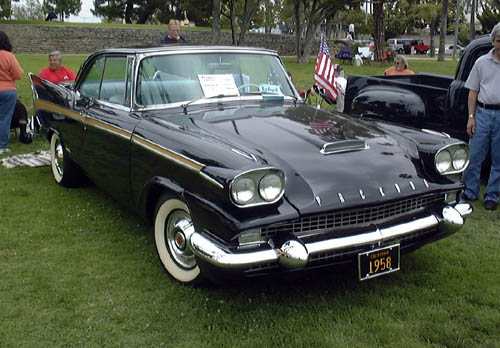
softballdaddy supplied an image of a 1958 Studebaker Golden Hawk. It was both luxurious and powerful. The 4.7L V-8, with supercharger, could produce 275 brake horse power (bph). The large engine necessitated the raised portion in the hood. Car critics considered the car "front heavy." Professional racers, however, didn't experience handling problems. This model was actually a precursor to the Muscle Car era of the early 1970s. It was capable of out running the Corvette in a 0-to-60 race. Top speed was 125mph, not bad for a production model during that period.
.jpg)
The chief designer was the famous French born American industrial designer Raymond Loewy. He was noted for his streamlining approach to ordinary consumer products, including mechanical pencil sharpeners.
.jpg)
Loewy was also the designer of the one of a kind Avanti, produced in 1963, the last year of the Studebaker Corporation's existence.
.jpg)
Studebaker continued the Hawk series until its demise in 1963-64. It culminated in the Loewy inspired Grand Turismo. Even today, in my opinion, the overall silhouette, sleek, yet imposing, with the European style grill, low to the ground look, exudes a quiet elegance that would still make it a head turner.
.jpg)
I have often thought the Honda Ridgeline was the closest thing to the Rancheros and El Caminos of my youth
Cool. They are all over the United States, believe it or not.
KOOL STUFF I AM WRITING BOOK ON OLD ABANDONED GOLD MINES IN THE US.
Marilyn Monroe in 1958
In 1958, Life Magazine invited Marilyn Monroe and photographer Richard Avedon to recreate images of five celebrated actresses of different eras. Entitled “Fabled Enchantresses,” the piece was part of the magazine’s December 22 “Christmas” issue and included an article by Marilyn’s playwright husband, Arthur Miller, entitled “My Wife, Marilyn.”
Avedon found in Marilyn an easy subject to work with, “She gave more to the still camera than every other actress – every other woman – I had the opportunity to photograph…” He added that she was more patient with him and more demanding of herself than others and that she was more comfortable in front of the camera than when not posing.
https://themindcircle.com/marilyn-monroe-recreate-celebrated-actresses-1958/#:~:text=In 1958, Life Magazine invited,actress – every other
This photo of Marilyn with the Borzoi that served as a prop for shots of her as Jean Harlow is the natural Marilyn.

When I first viewed the color photograph of her with the wavy, sort of curly, brown hair, large lips and overwhelming smile of even, white teeth I thought she could easily be an Indiana farm girl, who, at 18, for no other reason than sheer boredom, leaves family and the homestead to make her way to Gary where she finds work in a machine shop. The year was 1944. A year or so later and the boys would come home. She would marry one, have children, and live her adult days during the prosperous 1950s as mother and wife while hubby worked in a steel mill to pay for the diapers and the mortgage.
It wasn't Gary where she worked. It was in LA, her birthplace. She was a California girl. Had she been a bit younger, born at bit later instead of 1926, maybe she would have hung out with the surfers at Dana Point in the days when the exciting and dangerous sport of surf board riding was just gaining a foothold. She was athletic. She worked out.
The still photos of her fascinate in the way she seems to morph into someone else and then return to that person -- the Hollywood version -- she will always be known for.
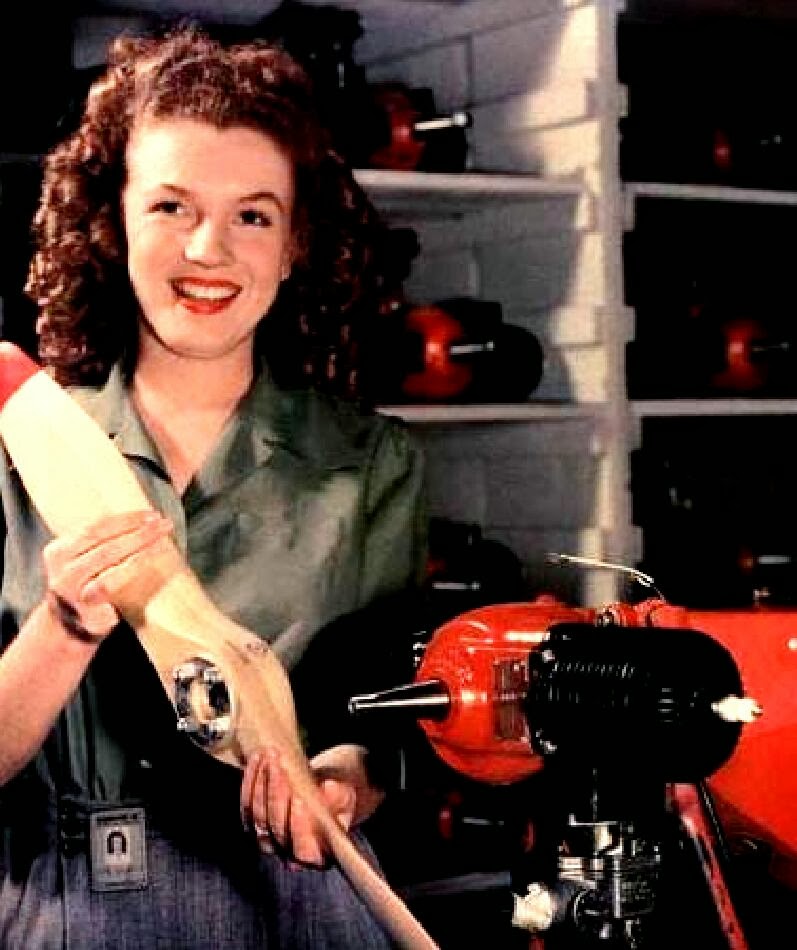
Posted by Kayleigh DeMace on Jul 19th 2017
When we think of Marilyn Monroe, we think of a seductive superstar of the 1950-60s. We think of Joe DiMaggio. We think of John F. Kennedy. We think of- airplanes?
Born Norma Jeane Mortenson, this forever famous actress and model's career came to be from her time working in an airplane factory.
The Rise of a Star
In late 1944, Marilyn Monroe was working in a Radioplane factory to help with the war efforts during WWII.
While working, Monroe met a photographer from First Motion Picture Unit, which led to a successful pin-up career. From there, the rest is history. Her early years-pre-movie star days-had a great influence on her life.
In the years leading up to this, Monroe lived in several foster homes and an orphanage. Still, her early years were happy. She was brought up by Albert and Ida Bolender, with her mother living with them for a while until work made that impossible. Still, she visited her mother on weekends and kept a healthy relationship and they soon lived together again.
However, in 1934, Monroe's mother had a mental breakdown and was diagnosed with paranoid schizophrenia. She rarely had contact with her daughter for the rest of her life from that point on.
Monroe eventually married her neighbor's son after her foster parents needed to move out of state-CA laws prohibited them from taking her with them. A marriage was the only way for her to avoid going back to an orphanage. She had just turned 16 years old.
Her husband, 21-year-old James Dougherty, enlisted with the Merchant Marines and was shipped out to the Pacific. Monroe moved in with her in-laws and began working at the Radioplane Company, which set off a chain of events in her incredible life.
Monroe at Radioplane Company
Primarily producing drones, Radioplane Company had a great influence during the second World War.
Monroe's main job at the factory was spraying planes with fire retardant. However, in this photo (right), she's shown assembling a drone. In fact, she's photographed here assembling the world's first mass-produced UAV, the Radioplane OQ-2.
Drones are thought of as a recent form of technology, but they have been used since before WWI.
US anti-aircraft gunners used these particular drones as gunnery targets to improve their targeting skills. Radioplane produced over 9,400 of these OQ-3 model UAVs.
This drone was a radio-controlled, small aircraft that was powered by a two-cylinder, two-cycle piston engine. It featured two contra-rotating propellers and was launched by a catapult. If it survived target practice, it was recovered by a parachute.
Perfect California Girl
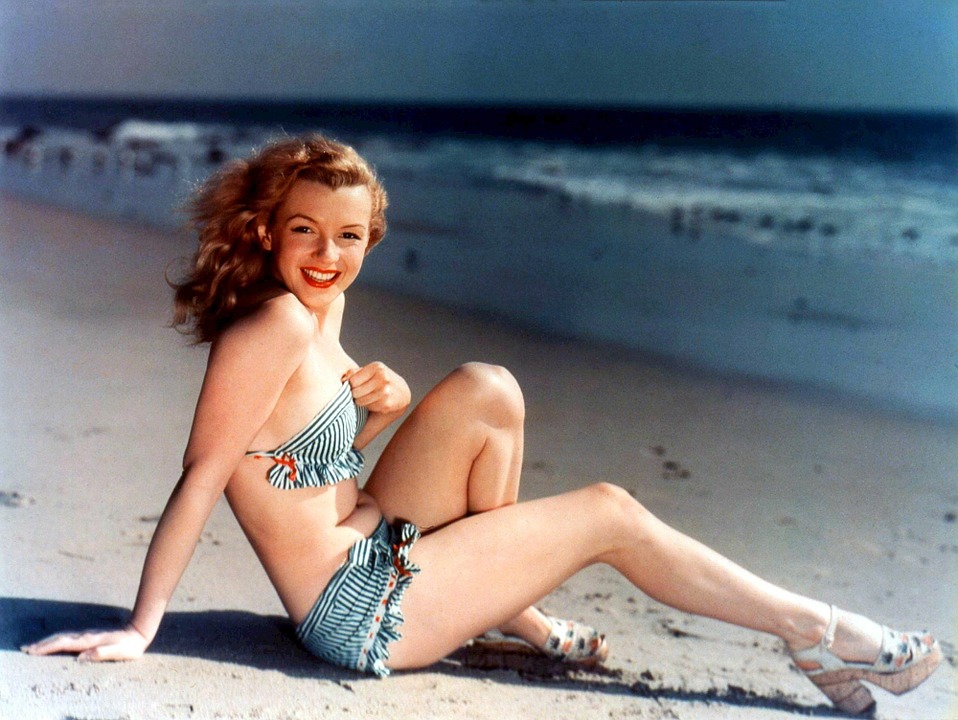
The 55 to 57 T birds don't usually reach six figures at auctions. Something much less than that. Mileage is a factor. Condition is a factor. As always the makers come up with a few models with extras just to squeeze a few more bucks from a customer. That can affect the price among collectors. Celebrity ownership is a factor but not always.
Good looking car and it sure fetched a good price.
Marilyn Monroe's 1956 Ford Thunderbird Sold for $490,000
The car was sold as part of an auction of Hollywood memorabilia.
By Joe Lorio
Nov 19, 2018
View Photos
Julien's AuctionsCar and Driver
UPDATE 11/19/18: Marilyn Monroe's Ford Thunderbird sold at auction last week for $490,000, almost reaching the Julien auction firm's top estimate of $500,000. That's not far from the most valuable Thunderbird ever sold: the first 'Bird to roll off the production line in 1954 sold for $660,000 at a Barrett-Jackson auction in 2009.
Of course Marilyn Monroe drove a Ford Thunderbird. It makes perfect sense. Ford's original, first-generation T-Bird roadster, which debuted for 1955 and was produced through 1957, was one of the sexiest cars of its time, and Monroe was the pre-eminent sex symbol. Today, both the T-Bird and the platinum-blonde movie star are among the most enduring pop icons of the '50s.
Specifically, Marilyn Monroe owned a Raven Black '56 T-Bird, and that car is now headed to auction this November as part of Julien's Auctions Icons & Idols: Hollywood. Monroe's ownership is documented, and according to information provided by the auction company, she bought the car in 1955, perhaps as a gift to herself on the release of The Seven Year Itch. Photos show Marilyn waving from the passenger seat with her husband at the time, playwright Arthur Miller, at the wheel, and the auction company reports that the pair drove the car to their wedding ceremony in 1956. In 1962, after owning the car for eight years, Monroe gave the T-Bird as a birthday present to Jason Strasberg, the son of director Lee Strasberg, who was also Monroe's acting coach. Monroe died in August of that year at age 36.
The car appears to be in excellent condition. Its black exterior is complemented by a black-and-white two-seat interior, period-correct wide whitewall tires, a black soft top, and a black hard top with a porthole window (which was new for '56). The pre-auction selling-price estimate is $300,000 to $500,000. That's against a current market value of $76,000 for a 1956 Thunderbird in #1 condition, according to the Hagerty Price Guide. That's a hefty celebrity premium, but for fans of the famous sex symbol and of 1950s pop culture more broadly, it doesn't get much better than this.

June 7--1958 Cadillac Eldorado Biarritz Part 6
When I spotted this image of a 58 Biarritz I liked the angle because I knew I could compare it with the 58 Corvette. One can see from the images how the Biarritz looks like an overgrown Vette, provided you remove the rear shark fins. This Biarritz has been lightly customized. The grille has been gold plated, which I think is a nice touch to break up the monotony of all that chrome. Notice how the two bodies are proportioned. Almost the same.
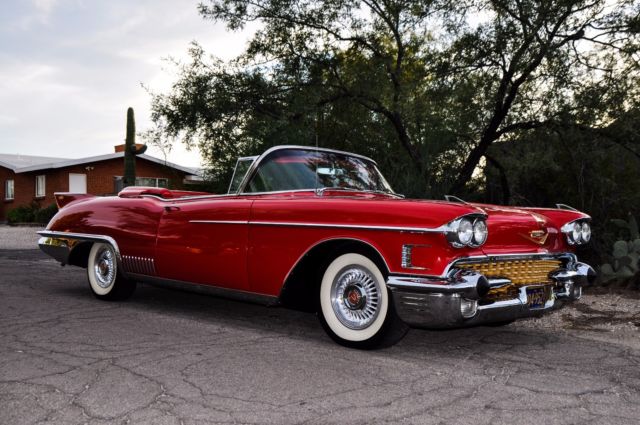
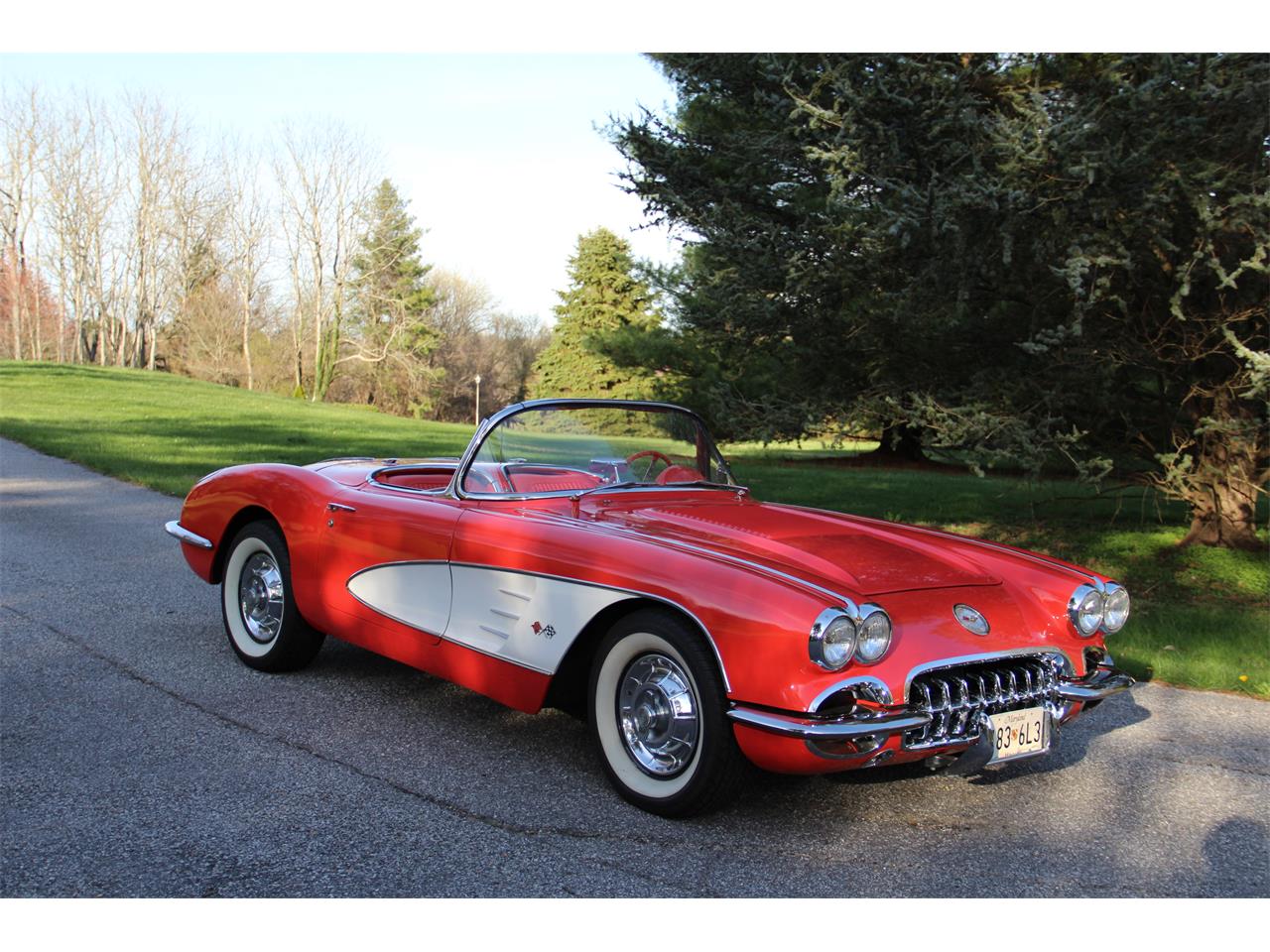
June 7--Cadillac Eldorado Biarritz Part 5
Would Hugh Hefner had run this ad in his Playboy magazine? The distinguished men in tux and bowler hat, with the grey temples, has that air of total self confidence, a man who's made in the market and is enjoying the fruits of victory. Beside him, in full gown and armlength white gloves, a lovely and classic looking blonde in blue satin. Trophy wife? Arm candy for a night on the town? Unashamedly rich, in other words, own Cadillacs.
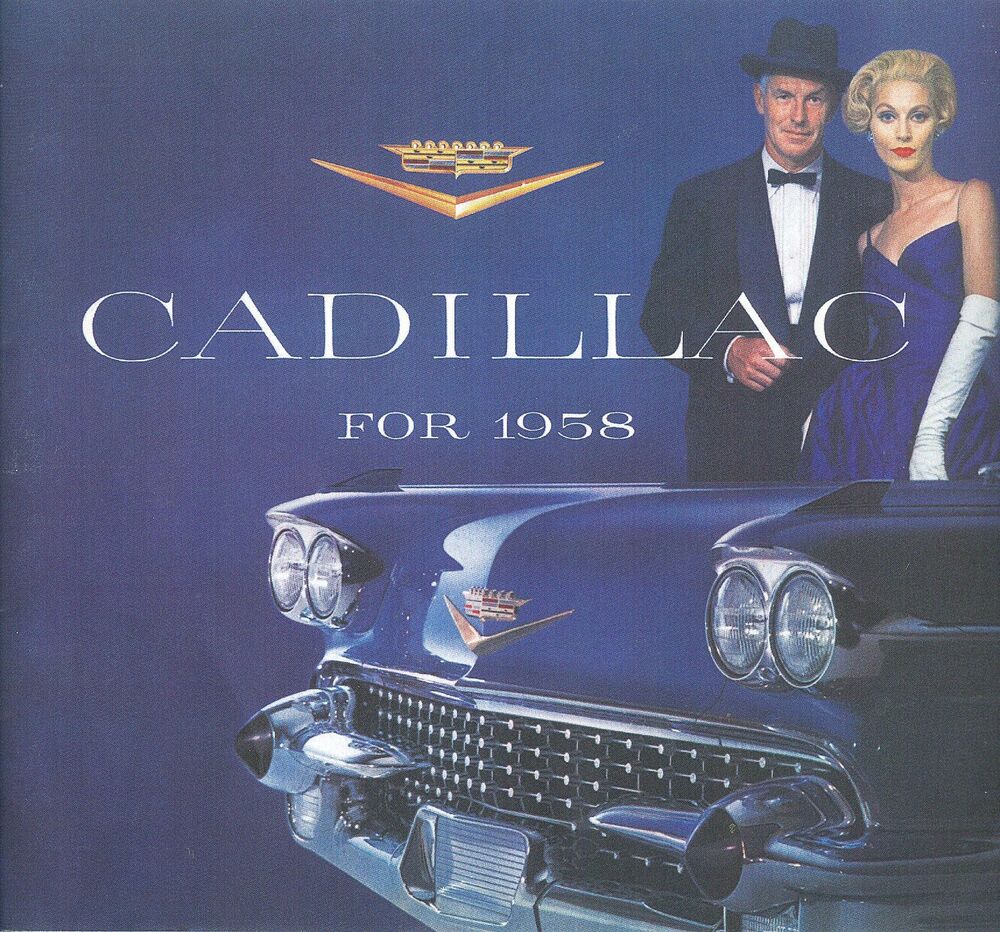
June 7--1958 Cadillac Eldorado Biarritz Part 4
During the 1950s, Cadillac held nothing back when it came to letting magazine subscribers know who its target market was. Men in top hats, women in furs, with Caddies parked at the entrances to upscale restaurants, swank resorts, opera houses. Most ads were elaborate illustrations. Commercial artists made a lot of money from Cadillac.
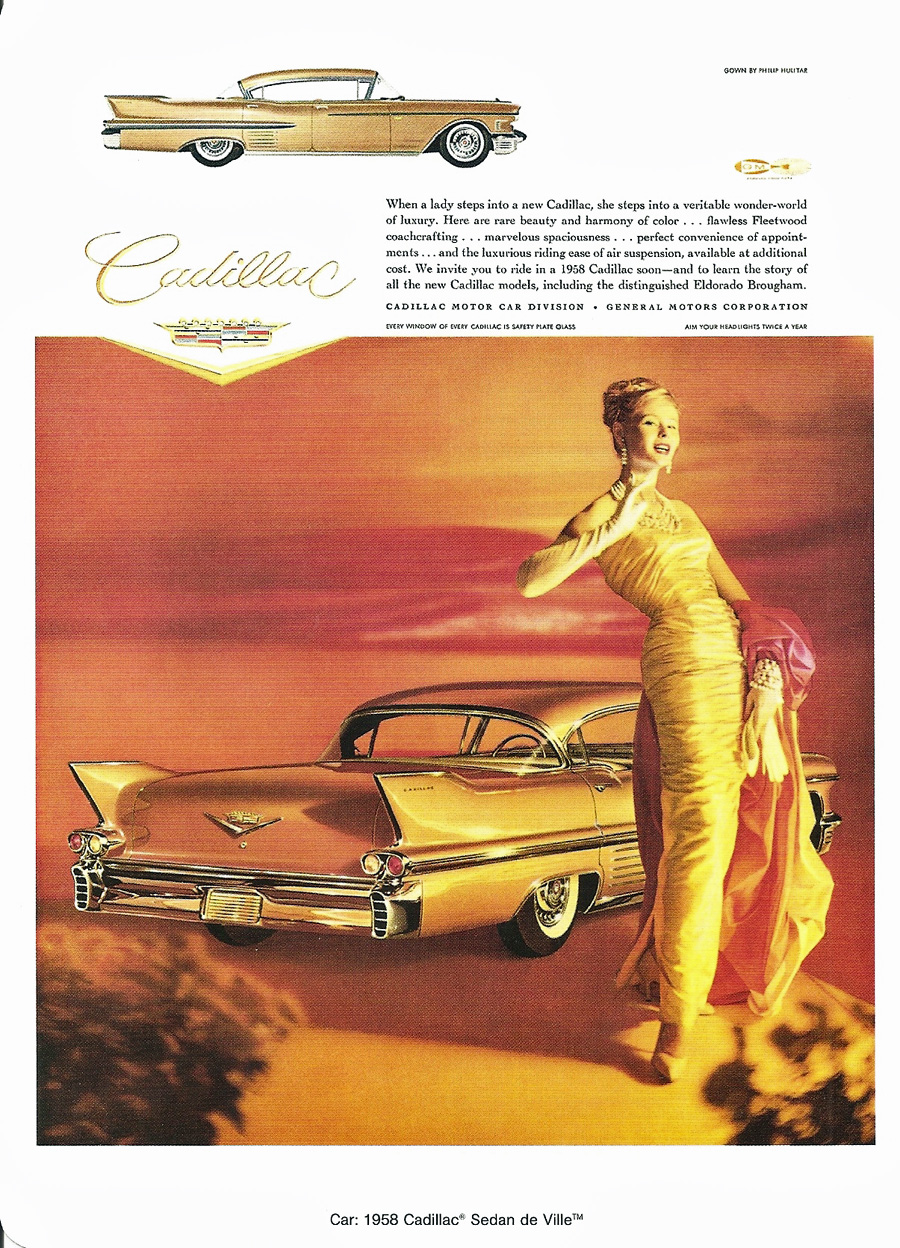
June 7--1958 Cadillac Eldorado Biarritz Part 3
I chose this image of the front end for the color. I can't quite determine if it is a metallic brown, or metallic lilac. Note the cleats in the grille, the massive wrap around bumper, and the Dagmar nosecones with the rubber inserts. Was all this intended to connote some kind of Space Age or rocket design? Also notice those little finlets above the quad headlamps which also sport what looks like eyeshades.
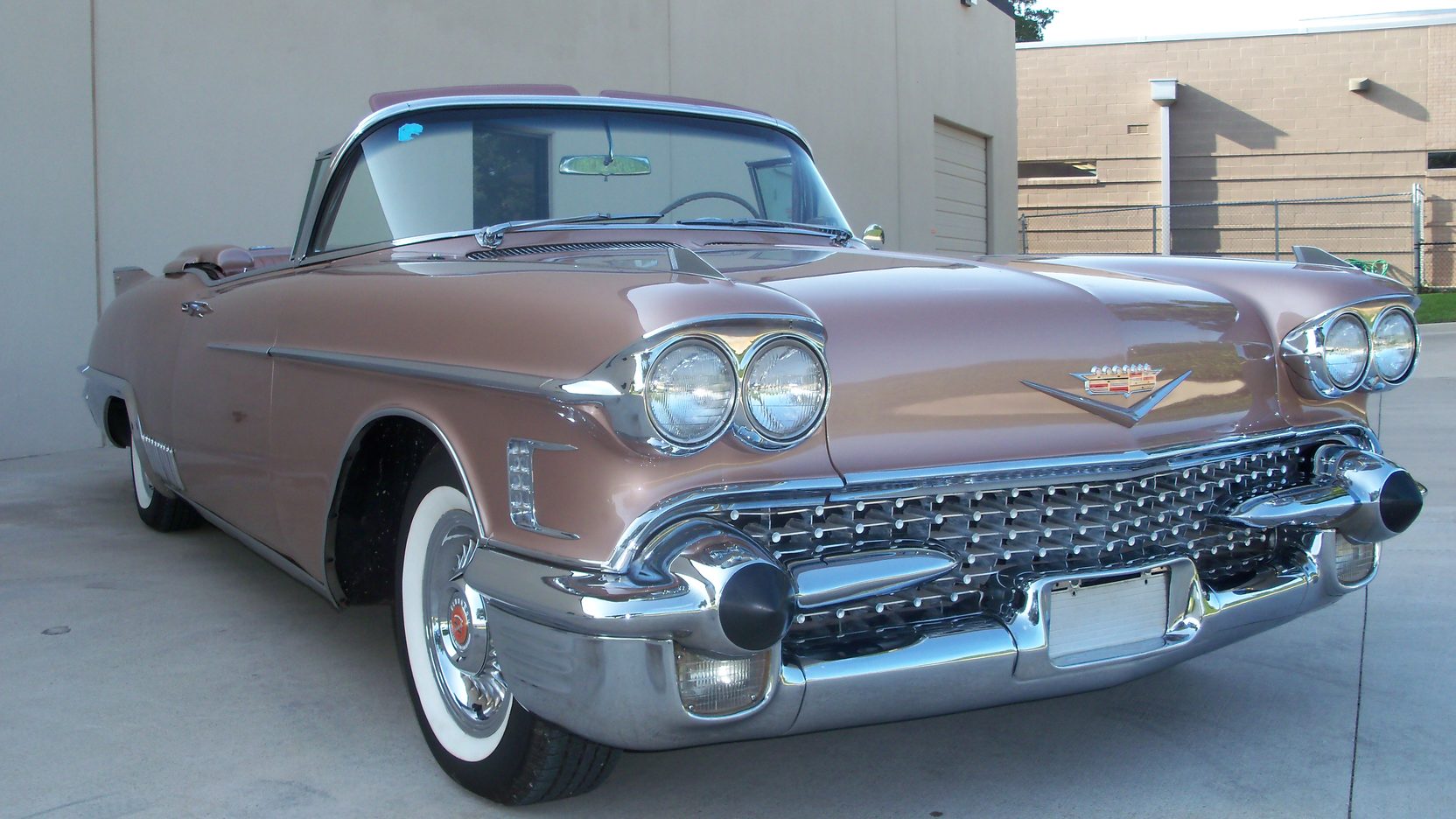
June 7--1958 Cadillac Eldorado Biarritz Part 2
This is an image of the interior of the 58 Biarritz. Typical GM styling of the period. Everything that could be electric was electric. The Wonder Bar radio only carried AM.
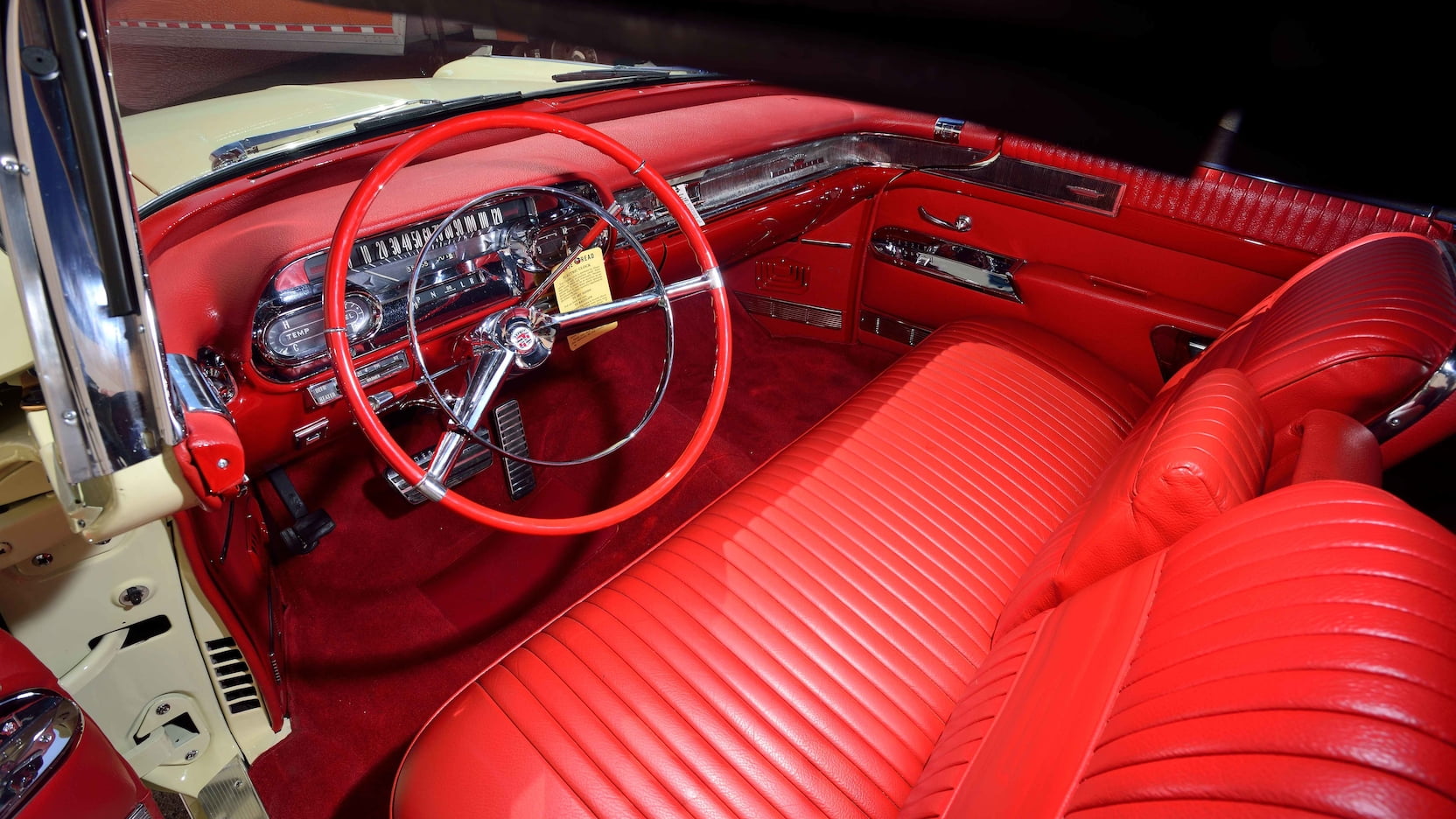
An interesting piece of automobile history is that Cadillac was formed by the breakup of Henry Ford’s company in 1902 due to a dispute between Ford and his investors.
The investors were trying to sell the assets from the closed factory when instead they decided to continue making automobiles by the urging of Henry Leland a Detroit manufacturer who also happened to have built a new engine. Leland convinced the investors that his new engine was stronger than that of Olds and he could produce them cheaper. The Cadillac name chosen for this new venture was the namesake of the explorer and Detroit’s founder, Antoine de la Mothe Cadillac.
General Motors would go on to purchase Cadillac in 1909 and eventually Cadillac became the luxury automobile and SUV division of General Motors Corporation.
The Cadillac Eldorado
The Cadillac Eldorado was a top of the line model. The Eldorado was introduced in 1953 and lasted continuously to 2002. The 1953 Eldorado was a limited edition convertible. The 1958 Cadillac Eldorado shown here is of the third generation models which were built from the 1957 through 1960 model years.
The Cadillacs of the 1950’s are remembered by their vast display of chrome.
Harley Earl and the new 1958 Cadillacs
Automobile design historians are well aware of the long tenure at General Motors by design chief Harley Earl. In short, Earl was hired by Alfred Sloan to be in charge of the styling section to design LaSalles. That worked out well and Earl was then put in charge of GM’s new “Art and Styling Studio” where he would head design for GM’s entire line. Essentially Harley Earl joined General Motors as a head designer and remained so for over thirty years.
Harley Earl was the head designer of the team working on the new 1957 Cadillac designs. These designs would mark the 1957 and 1958 Cadillacs. One of the major changes to these third generation models were the double headlights on each front side. The 1959 models would have much larger tail fins and perhaps the largest ever.
The 1958 Cadillacs received a modest facelift. Cadillacs for 1958 were basically carryover models from 1957 with a facelift on all but the Brougham. There was a new grille with multiple round “cleats” at the joining of horizontal and vertical members. The grille was wider and the bumper guards were set lower to the parking lamps. New quad headlights were seen on all Cadillac lines and small chrome fins were placed on the front fenders. Tailfins were somewhat less pronounced in 58 and trim attachments were revised. The Cadillac name was seen, in block letters, on the tailfins of Series 62 base models. On the sides of these models were five longer horizontal windsplits placedahead of the unskirted rear wheel housings.
The 1958 Recession Automobile Market
Sales were relatively poor in 1958. The reason was not the automobile itself but rather a recession that the country was in. Cadillac produced a total of 121,700 vehicles for the 58 model year.
The 1958 recession brought about the worst car sales year since World War Two. Overall American new car sales decreased 31 percent from 1957 levels. Fortunately, the recession ended during the last half of the year and sales picked up for 1959.
1958 Cadillac Eldorado Specifications
The 1958 Cadillac Eldorado had a 365 cubic inch V-8. The engine delivered 312 HP and was used in all Cadillacs that year. Eldorado performance was substantially improved with the adoption of three two-barrel carburetors, which boosted output to 335 HP.
June 7--1958 Cadillac Eldorado Biarritz Convertible
Cadillac introduced its Eldorado, named for a mythical Central America place of untold riches in 1953. The Biarritz was convertible version of the model. 1958 was a recession year. Only 815 were produced, making somewhat rare model that go at auction for around $150,000. That's no where near an eyebrow raising value compared to Ferrari GT 250 models that sell for $20 million to $70 million.
I chose this image, in black, with red interior, because of the distinct contrast with all that chrome.
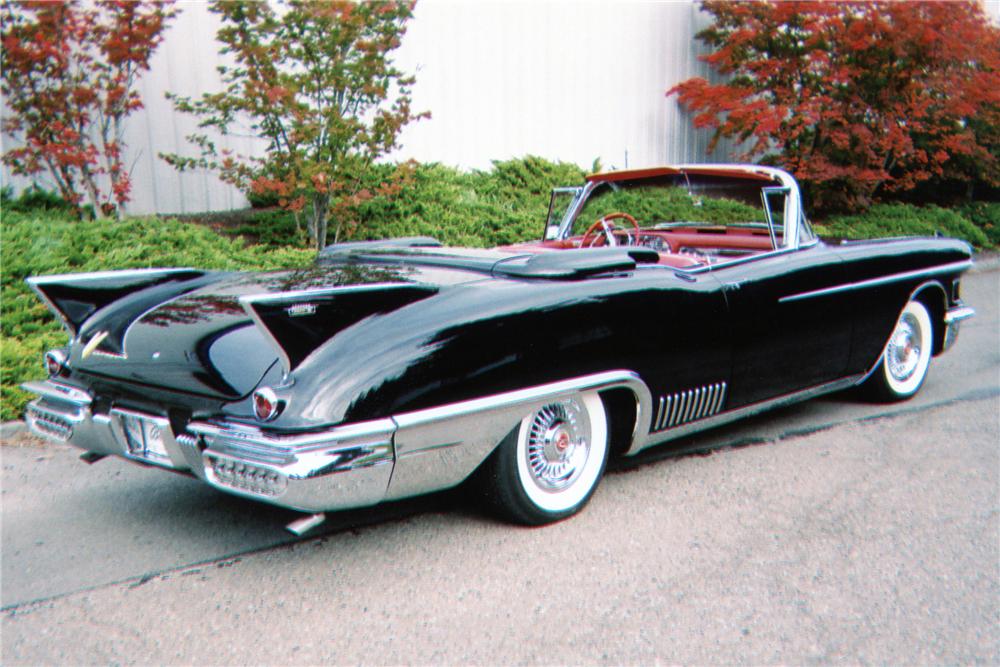
50s models from Detroit's big three featured wrap around front and rear bumpers. And those tailfins trimmed in chrome to make them standout. Note the hashmarks on the side. There are ten. The rear fins also sported a Cadillac badge just so folks would know what make of car the guy in the driver's seat was driving. The wide white wall tires were popular during the 50s. Why Caddy didn't include wire spoke rims like those on the Buick Skylark in 53 and 54 could be viewed something of a design oversight.
Another design motif in such a large car is the way Cadillac tried to make it appear sporty in the way one thinks of a European two seater. The slope in the trunk portion contrasts with the massive front portion, which had to be considering underneath the hood was a giant V8 engine.
OK, I had assumed you were fairly new to IHUB. Just skimmed thru your early posts, including those from '09 and '10.
"I own shares of other companies, most of which were purchased in 2009 and 2010."
1958 was actually a recession year, the Eisenhower Recession it was called. Sales were below average for all makers. The 1958 Thunderbird, Robert McNamara's brainchild, was the only model that saw a year of over year increase.
Those huge luxury land boats saw dismal sales. Only a few thousand at best. One would think the limited number would make them highly valuable among collectors. Rarity is a factor, but other factors affect collector value.
Convertibles have never really caught on in America. The British makers imported those little two-seaters going back to the 1930s. Chevrolet's Corvette sale didn't hit 10,000 until after 1960.
I own shares of other companies, most of which were purchased in 2009 and 2010.
You've found some amazing cars. Younger readers should realize that almost no one drove cars like that very costly '58 Imperial. Maybe some did in LA, but where I live fairly plain Chevys and Fords dominated the roads. There WERE fins-a-plenty. I remember being in a friend's then-rare early '60s VW and getting yelled at for not driving in an American car.
When I started making the Big Bucks as a lawyer ($9,800) I came close to buying a used Triumph, but gave up on that idea because I couldn't drive a stick. Can you?
Monk, do you own stocks besides SMG and ROK?
|
Followers
|
10
|
Posters
|
|
|
Posts (Today)
|
0
|
Posts (Total)
|
88
|
|
Created
|
10/24/19
|
Type
|
Free
|
| Moderators | |||
| Volume | |
| Day Range: | |
| Bid Price | |
| Ask Price | |
| Last Trade Time: |
